By KERRY WORTHINGTON, Leaders in Energy
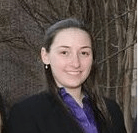
Leaders in Energy partnered with the Center for Leadership in Global Sustainability at Virginia Tech in Arlington, Virginia along with Arlington Green and the International Society of Sustainability Professionals in conducting this event on the topic of Urban Sustainability on October 8, 2015.
Event themes included:
• Green infrastructure developers cannot ignore the benefits of trees in urban sustainability;
• We are stronger together than apart, and many organizations are invested in bridging those gaps;
• Tree planting is fantastic, tree maintenance is just as important
• Incorporating the arts into the sciences can help to communicate these topics to broader audiences, see more on “Thermal Pearl Rising” dance performance
+++++++++++++++++
Welcoming the audience on behalf of our sponsors were Michael J. Mortimer, Director at the Virginia Tech Center for Leadership in Global Sustainability (CLiGS), Jenn Trong also from CLiGS, Mark Friedman from the International Society of Sustainability Professionals, Agustín Cruz from ArlingtonGreen, Janine Finnell from Leaders in Energy, and Larry Wiseman, also from CLiGS. There was also an announcement that the world premier performance of Thermal Pearl Rising, a performance piece on climate change, by the Bowen McCauley Dance Company would take place for the audience after a refreshment break and networking.
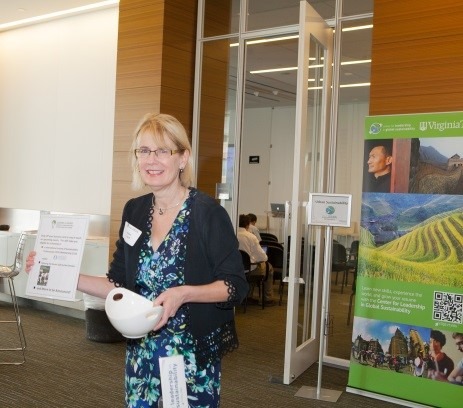
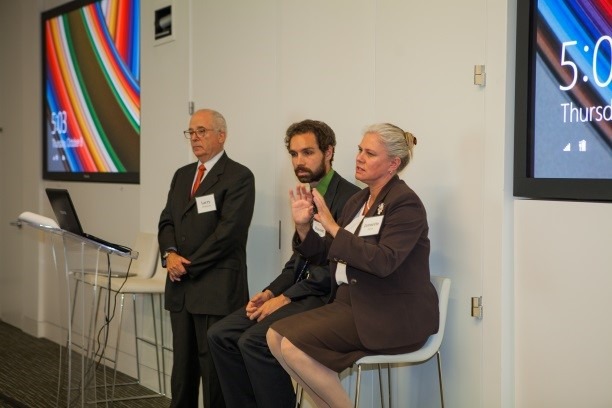
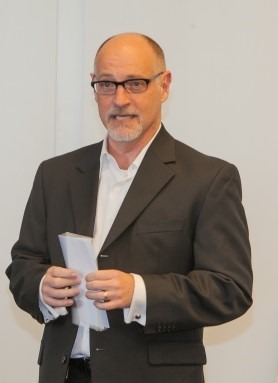
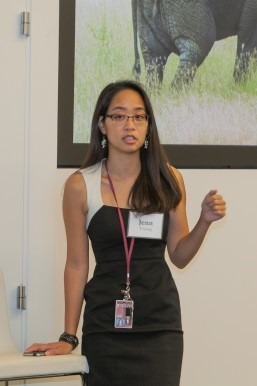
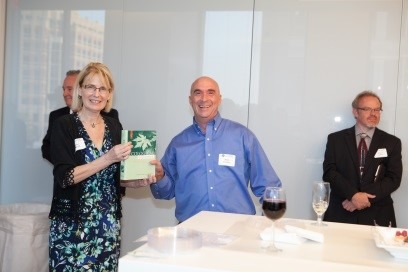
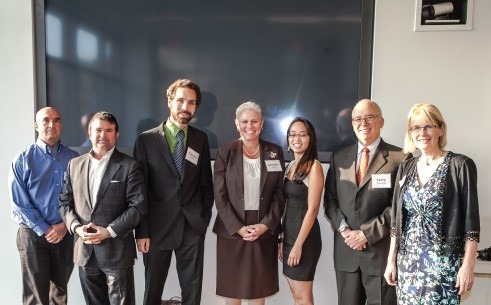
Trees Are Key to a Vibrant Community
Before introducing Janette (Jan) Davis, Assistant Director in the Cooperative Forestry Program of the USDA Forest Service, Larry noted that projections are claiming that 80-85% of the population will live in a metropolitan area in a century. Conservation of the ecosystems, particularly where people live, is often missed, and to develop a Vibrant Community, Trees are key.
“Does anyone recognize this tree?” Jan said, while motioning towards the screen with a picture of her and a horse apple tree that Jefferson gave to Washington to demonstrate “how important trees are to our nation.” Indeed, “trees are the key” to the economy, our water systems, energy efficiency, infrastructures, and communities on a whole. In 2011, 25 specialists developed the Vibrant Cities Report to examine the benefits of trees and develop 12 recommendations on health, landscape design and economics.
Interestingly, the Forest Service (USFS) is a division of the Department of Agriculture – not the Department of Interior. The USFS not only protects the big forests out west, but state and private land too, including 136 million acres of existing and potential urban forest land. “We can’t stop at the border” Jan said, adding that the Service’s motto is “caring for the land and serving people.”
Jan also explained the Urban and Community Forestry (UCF) Program. The Department of Housing and Urban Development and the Environmental Protection Agency (EPA) are two of the largest partners in the Program, and small non-profits also help to maintain the program. Two-thirds of the Program’s budget goes into the states and each state must have a point of contact that is either an employed or volunteer urban forester or a technical assistant.
The Importance of Tree Canopy Coverage
A common goal among the states is to have a 40% tree canopy coverage. Another goal of the program is to improve 13 rivers in big cities to make them accessible to the public for education and recreation. Jan then talked about three UCF challenges:
1. Integrating urban forestry as part of large scale regional planning in large geographies such as the Baltimore-Washington corridor, Atlanta, and Portland-Vancouver spread. For example, the Intertwine Alliance creates regional plans and incorporates urban forestry through conservation, education, acquisition, regional systems, and active transportation.
2. Strengthening the health of forests and reduce impact of invasive pests and species. For example, Vermont’s Forest Pest Detectors programs develop citizens to help identify invasive bugs such as the “Emerald Ash.” More local and state programs are using this “citizen science” volunteer program to increase awareness, accuracy and response time to invasive species.
3. Increase funding and diversify investments for forest health. To meet goals, states may have to increase their budget for planting and maintaining trees. California is incorporating Urban Forestry into their utility Cap and Trade program through their Department of Forestry and Fire Protection and many other utilities have or are mandated to have a tree replacement program.
Another take away that it is important to ensure many types of trees are being planted and maintained to encourage biodiversity and long term success. Jan also mentioned the Partners in Community Forestry Conference hosted by the Arbor Day Foundation, with partners and 500 participants, to meet in Denver, Colorado on November 18-19, 2015.
A common question about these programs is “how many trees have you planted?” especially in light of “million tree campaignings” however, success in maintenance is also vital. Communities through the UCF program, data has been collected about the benefits of trees and their canopy. Although many facts were on the presentation, Jan emphasized that trees have been shown to:
– decrease child ADD, Asthma, improve hospital recovery time,
– decrease stress, carbon and other pollutants,
– improve the economy.
Urban Tree Canopy and the Climate Action Plan
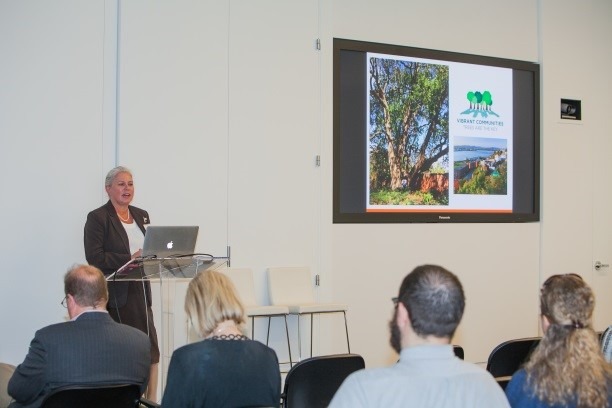
The work towards a larger urban tree canopy fits into the President’s Climate Action Plan which aims to cut carbon pollution, prepare the country for the impacts of climate change, and lead global efforts. The USDA put together ten “building block” teams to address implementation of lowering greenhouse gasses. The Forest Service is responsible for developing options for these building blocks including:
1. Private forest growth and retention;
2. Stewardship and federal forests;
3. Promotion of wood products, and;
4. Urban forests.
Jan then elaborated on the Urban Forests Building Block. Through a partnership with Arbor Day Foundation, the USFS UCF program developed the Energy Saving Trees tool. The GIS tool assesses how a tree type, size and placement can contribute to energy efficiency as well as other benefits. Larry spoke more on that tool later in the program.
Methods for Quantifying the Program’s Success
Before concluding and questions from the audience, Jan touched on some of the ways that the program quantifies success including energy saved, carbon sequestered, water saved, and economic value. Additionally, the National Urban and Community Forestry has an Advisory Council with a ten year action plan and seven goals, to be released in November 2015. A prime topic from the audience discussion was about tree planning and removal, especially with tree health and diseases, such as the Dutch Elm disease.
A smooth transition welcomed Vincent Verweij to the podium to speak on Arlington County’s Urban Forest and Green Infrastructure. After a quick review of his topics, he jumped into describing the essential value of trees – which included the five main areas of value: air, energy, water, the economy, and health.
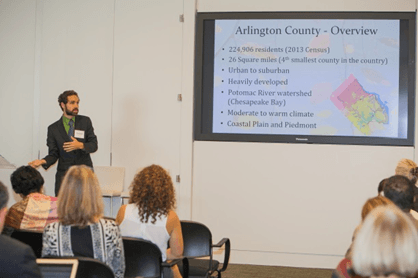
Vincent gave an overview of Arlington County, which has almost 225 thousand residents as of 2013, 26 square miles, and two types of sediment, coastal plan and piedmont, which gives two distinct types of soil and species makeup. The tree canopy, excluding Arlington Cemetery, is roughly at 40%, which again is a common American forest target. Vincent noted two prominent trends: there tends to be more canopy in the piedmont sediment and less canopy where there are urban corridors. Where there are urban corridors, there is less water and carbon being stored in the soil. Common threats to an urban forest include storms, invasive plants, wildlife (deer) preventing regrowth, pests and diseases, climate change, development, and poor practice.
The Climate Change Affect
Planners today are making choices about which types of trees to plant based on uncertainty such as climate change. Climate change may bring warmer temperatures, colder temperatures, or more extreme weather in general and different types of trees withstand those pressures more effectively. However, there are several tree laws and ordinances to guide some of this planning. The Chesapeake Bay Ordinance, adopted in 2003 for storm water management, is a huge influence, however the Resource Protection Area restrictions are also a large influence.
Arlington County also has several programs, including an Urban Forest Master Plan, to aide in facilitating canopy growth. The plan was adopted in 2004 with a target to begin updating the plan in 2016. A portion of this plan includes the Public Spaces Master Plan. Through the planning and maintenance program, Arlington has averaged planting 650 trees per year focusing on native plants, as well as diversifying – Arlington has 150 common species. Two programs help facilitate the tree canopy on private lands: Tree Canopy Fund Grant Program and the Tree Distribution Program.
Through these programs, Arlington has developed standards and best practices, as well as collaboration and outreach. Tree protection, “right tree, right place,” and assessments have improved the tree canopy in Arlington. By collaborating with other counties, planning, transportation, parks, public schools, and community groups have benefited from tree development.
Vincent then talked about new and “newish” ideas in green infrastructure with trees. Some take-aways include:
– The larger the tree canopy, the greater the impact;
– The healthier the soil there is, the healthier the trees will be, as well as the air;
– Providing the space for a tree to work is beneficial for the survival of the tree
As part of the redevelopment of the Ballston Metro landscape, Vincent noted that he needed to integrate his department into their planning before decisions were made. The timing was a key to ensuring that the landscape had trees, not bushes, and the facility was multi-purposed for storm water and soil. If the department would have intervened after the plans had been set, the project would have been a lot less likely to comply with the departments goals.
Children Get Exposed to Green Spaces
There are other ways to be creative about green spaces and infrastructure. There is opportunity to develop street medians for vegetation, rain gardens where applicable, green roofs, and passive houses. Arlington has a 64% tree canopy in parks. They use parks as an opportunity to emerge children in educational programs, such as observing and introducing them to green roofs and rain gardens.
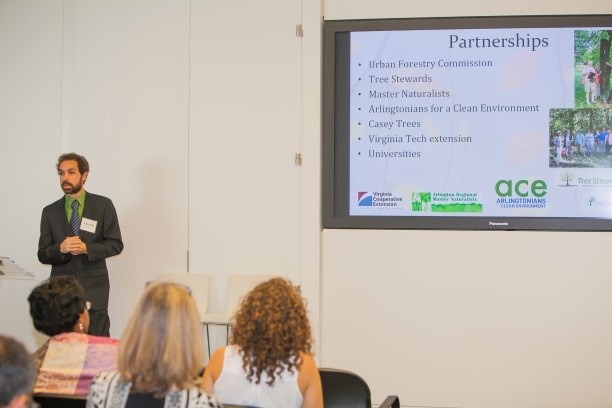
Arlington partners with several organizations: the Urban Forestry Commission, Tree Stewards, Master Naturalists, Arlingtonians for a Clean Environment, Casey Trees, the Virginia Tech extension and other universities. In summary the Vincent and Arlington wants to “protect our existing canopy; plant for the future; improve practices and designs; be proactive in planning for resilience; integrate trees as a necessary part of green infrastructure; and communicate the value of threes and green infrastructure.” In the audience discussion portion of his program, Vincent also addressed competing and agreeing goals with solar, including new communities and affordable housing in the plans, and tree diseases.
Larry Wiseman began his presentation demonstrating the Green Infrastructure and Forestry Toolkit (GIFT) and iTree programs. A big takeaway from his presentation is that there is more to be done to break down silos within urban development. Many local, city, and state authorities make decisions without having the proper coordination.
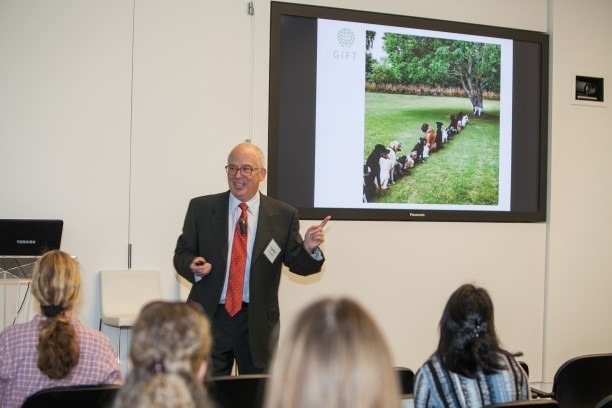
The National Association of Regional Councils asked CLiGS for assistance in developing a guide to urban forestry for all types of professionals. To solve some of these interdisciplinary knowledge transfer issues, the CLiGS, NARC, and the FS developed the GIFT (Green Infrastructure and Forestry Tookit). Much of Larry’s presentation involved demonstrating the website and its resources. There are many models, data sets, guides, and materials to aide in the development of a green infrastructure and urban forestry planning process.
Using the Green Bay area of Wisconsin and Charlotte, North Carolina, Larry talked through some of the challenges and solutions toward maintaining green infrastructure. There is a lot of work to be done to fill in knowledge gaps at the city and citizen levels, as well as with engineers that are doing a lot of the planning. There are over a dozen case studies in the GIFToolkit.
Having a process in place to determine what works and what doesn’t for municipality leaders is important to have a committed and coordinated team. A survey conducted by GIFT of planners and sustainability professionals concluded that committed municipal officials make a significant different, as does coordinated municipal departments, support from local leaders, and adequate GIS resources. Unfortunately, Larry noted that regional plans are often overlooked, although incentives are becoming more significant. When talking about motivators for engagement, quality of life motivates people more than the threat of climate change.
The iTree Design program allows a user to enter an address, select the building structure, model tree placement, and estimate benefits. The program calculates benefits overall, for stormwater, energy use, air quality, carbon dioxide, and in some cases property value. After a question from the audience, Larry clarified that there was no crowd sourcing capability of the program at this time. Small businesses have been the most responsive to this program.
Tree Damage Felt Over Time
Another interesting part of the discussion was post-storm cleanup of trees. In some cases, the destruction was obvious. Homeowners, the Federal Emergency Management Agency, other emergency professionals and contractors were quick to remove knocked down trees. However, Jan helped inform the audience that some trees do not appear to be damaged until six to nine months after the event. There are efforts in place to help emergency response professionals identify trees in need of renewal to shorten the lag time to replace the tree. Larry’s presentation concluded with a discussion of storm water infrastructure and water runoff.
Premiere Performance of Avant-Garde Dance Production on Climate
Change and Urban Environment –“Thermal Pearl Rising”
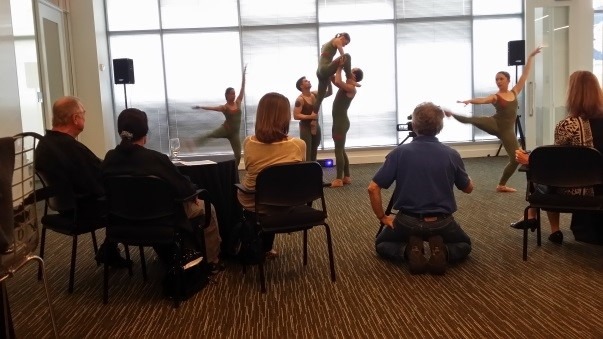
The audience took a break for refreshments with other groups on the floor of the building and came back together for the performance of Thermal Pearl Rising. In his opening remarks for the performance, Michael Mortimer said that a common question is why put the arts program in the same building as the Virginia Tech Research Center. His answer was that the arts help communicate science and leadership. The performance reflected how cities contributed to climate change and how cities can be the solution for climate change. He introduced Lucy Bowen McCauley, the Director of Bowen McCauley Dance, and she provided an overview of the performance. More information on the meaning behind this performance is also available in this article by the Center for Leadership in Global Sustainability.
The performance took the audience for a whirlwind and back. One by one, the five dancers joined the stage, wearing olive green body suits with several red zippers about eight inches long in sporadic places. In the first half, it appeared that the movements were sharp, hurried, and more and more closed off. Their contributions were independent, yet with the same consequence. The atmosphere was dim and hurtful with several dancers looking in a downward direction.
For a moment, their expression was unsure, until it turned toward a corner where they “saw the light.” The music changed, and so did their attitudes. They became synchronized, strong, and determined. The tone was reminiscent of a harvest – a celebratory act of serving a community greater than the self. The audience silent, mesmerized. At the end, they came together once more with a look of hopefulness and determination for change, much like our discussion regarding the trees.
Conclusion
Another informative and entertaining event of convening a community of leaders in the clean energy and sustainability arena concluded.
We look forward to our next event on “Four Generations: Clean Energy and Sustainability Leadership (Leading Through Adversity).” This will be Leaders in Energy’s second year to conduct this very successful event which will feature honorees from each of the four generations, e.g., World War II, Baby Boomer, Gen X, and Millennial who exemplify leadership in the energy and sustainability arena. Leaders in Energy is an inclusive organization promoting the interaction, partnership, and mentoring among all generations, with diverse backgrounds and work experiences.
The event will take place on December 4, 2015. More information is available at www.leadersinenergy.org.

About the author: Kerry Worthington began volunteering for Leaders in Energy in spring 2015. She is a young professional working in the state regulatory space, specifically on multi-state issues. Transmission system planning and analysis from a policy point of view has been her focus area for several years, and she is growing into the distributed generation area with an eye on environmental topics.
Photo Credits:Photos courtesy Agustín Cruz- augie.cruz@gmail.com-www.facebook.com/wecangreenarlington.


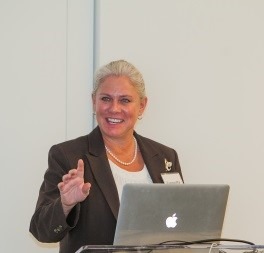
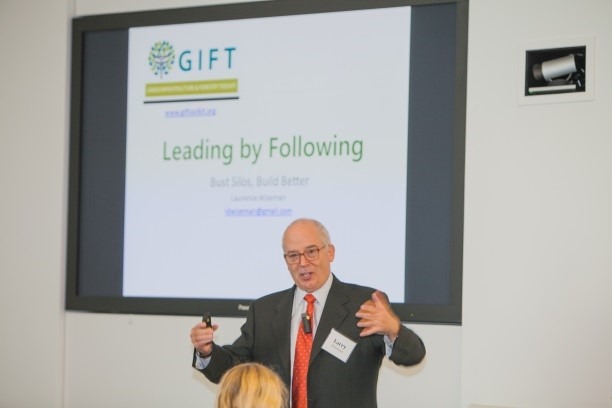
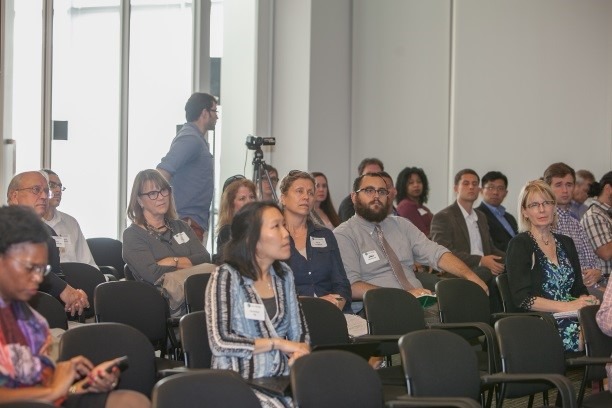
Leave a Reply